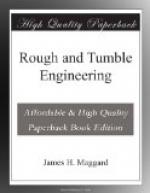An engine should never be allowed to drop from a set of planks down onto the floor of bridge. This is why I advocate four planks. Don’t hesitate to use the plank. You had better plank a dozen bridges that don’t need it than to attempt to cross one that does need it. You will also find it very convenient to carry at least 50 feet of good heavy rope. Don’t attempt to pull across a doubtful bridge with the separator or tank hooked directly to the engine. It is dangerous. Here is where you want the rope. An engine should be run across a bad bridge very slowly and carefully, and not allowed to jerk. In extreme cases it is better to run across by hand; don’t do this but once; get after the road supervisors.
SAND.
An engineer wants a sufficient amount of “sand,” but he don’t want it in the road. However, you will find it there and it is the meanest road you will have to travel. A bad sand road requires considerable sleight of hand on the part of the engineer if he wishes to pull much of a load through it. You will find it to your advantage to keep your engine as straight as possible, as you are not so liable to start one wheel to slipping any sooner than the other. Never attempt to “wiggle” through a sand bar, and don’t try to hurry through; be satisfied with going slow, just so you are going. An engine will stand a certain speed through sand, and the moment you attempt to increase that speed, you break its footing, and then you are gone. In a case of this kind, a few bundles of hay is about the best thing you can use under your drivers in order to get started again. But don’t loose your temper; it won’t help the sand any.
Now no doubt the reader wonders why I have said nothing about compound engines. Well in the first place, it is not necessary to assist you in your work, and if you can handle the single cylinder engine, you can handle the compound.
The question as to the advantage of a compound engine is, or would be an interesting one if we cared to discuss it.
The compound traction engine has come into use within the past few years, and I am inclined to think more for sort of a novelty or talking point rather than to produce a better engine. There is no question but that there is a great advantage in the compound engine, for stationary and marine engines.
In a compound engine the steam first enters the small or high pressure cylinder and is then exhausted into the large or low pressure cylinder, where the expansive force is all obtained.
Two cylinders are used because we can get better results from high pressure in the use of two cylinders of different areas than by using but one cylinder, or simple engine.
That there is a gain in a high pressure, can be shown very easily:
For instance, 100 pounds of coal will raise a certain amount of water from 60 degrees, to 5 pounds steam pressure, and 102.9 pounds would raise the same water to 80 pounds, and 104.4 would raise it to 160 pounds, and this 160 pounds would produce a large increase of power over the 80 pounds at a very slight increase of fuel. The compound engine will furnish the same number of horse power, with less fuel than the simple engine, but only when they are run at the full load all the time.




